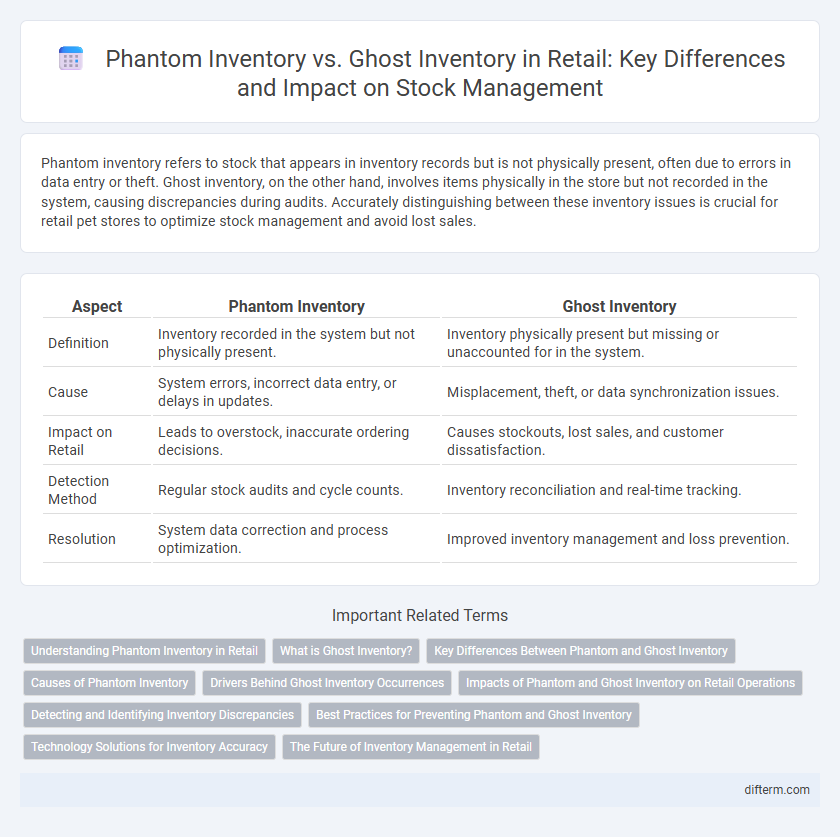Phantom inventory refers to stock that appears in inventory records but is not physically present, often due to errors in data entry or theft. Ghost inventory, on the other hand, involves items physically in the store but not recorded in the system, causing discrepancies during audits. Accurately distinguishing between these inventory issues is crucial for retail pet stores to optimize stock management and avoid lost sales.
Table of Comparison
| Aspect | Phantom Inventory | Ghost Inventory |
|---|---|---|
| Definition | Inventory recorded in the system but not physically present. | Inventory physically present but missing or unaccounted for in the system. |
| Cause | System errors, incorrect data entry, or delays in updates. | Misplacement, theft, or data synchronization issues. |
| Impact on Retail | Leads to overstock, inaccurate ordering decisions. | Causes stockouts, lost sales, and customer dissatisfaction. |
| Detection Method | Regular stock audits and cycle counts. | Inventory reconciliation and real-time tracking. |
| Resolution | System data correction and process optimization. | Improved inventory management and loss prevention. |
Understanding Phantom Inventory in Retail
Phantom inventory in retail refers to stock that is recorded in the inventory management system but does not physically exist, often caused by errors in data entry, theft, or misplacement. This discrepancy leads to inaccuracies in stock levels, resulting in lost sales and inefficient replenishment strategies. Effective detection and resolution of phantom inventory are crucial for maintaining accurate supply chain operations and improving overall store performance.
What is Ghost Inventory?
Ghost inventory refers to stock that appears in a retailer's inventory management system but is physically absent from the warehouse or store. This discrepancy often arises from data entry errors, theft, or unrecorded sales, leading to inaccurate stock levels. Managing ghost inventory is crucial for optimizing supply chain efficiency and preventing lost sales due to false stock availability.
Key Differences Between Phantom and Ghost Inventory
Phantom inventory refers to stock that appears in the inventory system but is physically absent due to errors like miscounts or theft, causing discrepancies in sales and ordering processes. Ghost inventory involves non-existent stock recorded due to system glitches or data corruption, leading to false availability and impacting demand forecasting accuracy. Both types disrupt inventory management but differ fundamentally in origin--phantom inventory arises from physical or operational inaccuracies, while ghost inventory stems from technical data issues.
Causes of Phantom Inventory
Phantom inventory occurs primarily due to data entry errors, theft, misplaced stock, or unrecorded sales, which create discrepancies between recorded and actual inventory levels. System glitches and inaccurate barcode scanning also contribute significantly to phantom inventory issues. Understanding these causes helps retailers implement precise inventory tracking and reduce financial losses.
Drivers Behind Ghost Inventory Occurrences
Ghost inventory occurrences in retail primarily stem from data inaccuracies caused by theft, administrative errors, and system integration failures. These drivers disrupt inventory visibility by falsely indicating stock presence when items are physically missing. Addressing issues in supply chain tracking and improving real-time inventory updates can significantly reduce ghost inventory incidences.
Impacts of Phantom and Ghost Inventory on Retail Operations
Phantom inventory leads to inaccurate stock records, causing lost sales and increased carrying costs due to products believed to be available but actually out of stock. Ghost inventory involves items physically present but not recorded in the system, resulting in missed replenishment signals and distorted demand forecasts. Both types of inventory discrepancies disrupt supply chain efficiency, degrade customer experience, and inflate operational expenses in retail environments.
Detecting and Identifying Inventory Discrepancies
Phantom inventory refers to stock that is recorded in the system but physically missing, while ghost inventory describes items physically present but unaccounted for in records. Detecting these discrepancies involves leveraging advanced inventory management systems, RFID technology, and regular cycle counts to compare digital records against physical stock. Accurate identification of such variances helps prevent stockouts, reduces shrinkage, and optimizes replenishment strategies in retail operations.
Best Practices for Preventing Phantom and Ghost Inventory
Implementing accurate cycle counts and real-time inventory tracking systems significantly reduces phantom and ghost inventory discrepancies in retail environments. Leveraging RFID technology and integrated point-of-sale software ensures continuous synchronization between physical stock and inventory records. Employee training on proper stock handling and regular audits helps maintain data integrity and prevents inventory miscounts.
Technology Solutions for Inventory Accuracy
Phantom inventory refers to stock records indicating items that are physically absent, while ghost inventory denotes nonexistent items listed in the system. Advanced technology solutions such as RFID tracking, IoT sensors, and AI-powered inventory management systems improve inventory accuracy by providing real-time visibility and automated discrepancy detection. Implementing these technologies reduces stockouts and overstock situations, optimizing supply chain efficiency and enhancing customer satisfaction.
The Future of Inventory Management in Retail
Phantom inventory refers to stock recorded in the system but physically absent, while ghost inventory is nonexistent stock that appears available due to data errors. Emerging technologies like AI-powered analytics and real-time IoT tracking are revolutionizing inventory accuracy, minimizing discrepancies caused by phantom and ghost inventory. Retailers leveraging blockchain for transparent supply chain data and machine learning for predictive inventory management are set to enhance operational efficiency and customer satisfaction.
Phantom Inventory vs Ghost Inventory Infographic

 difterm.com
difterm.com